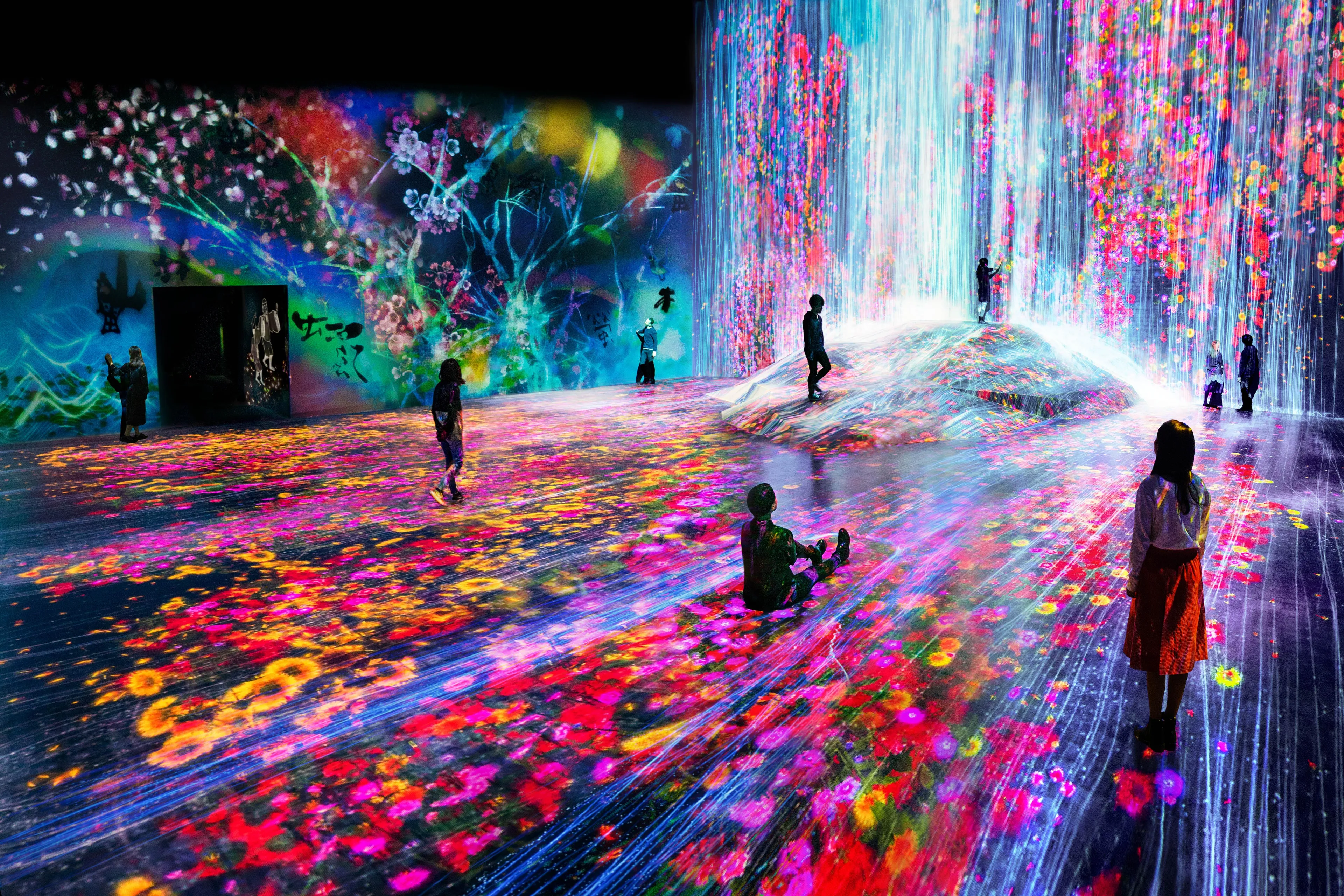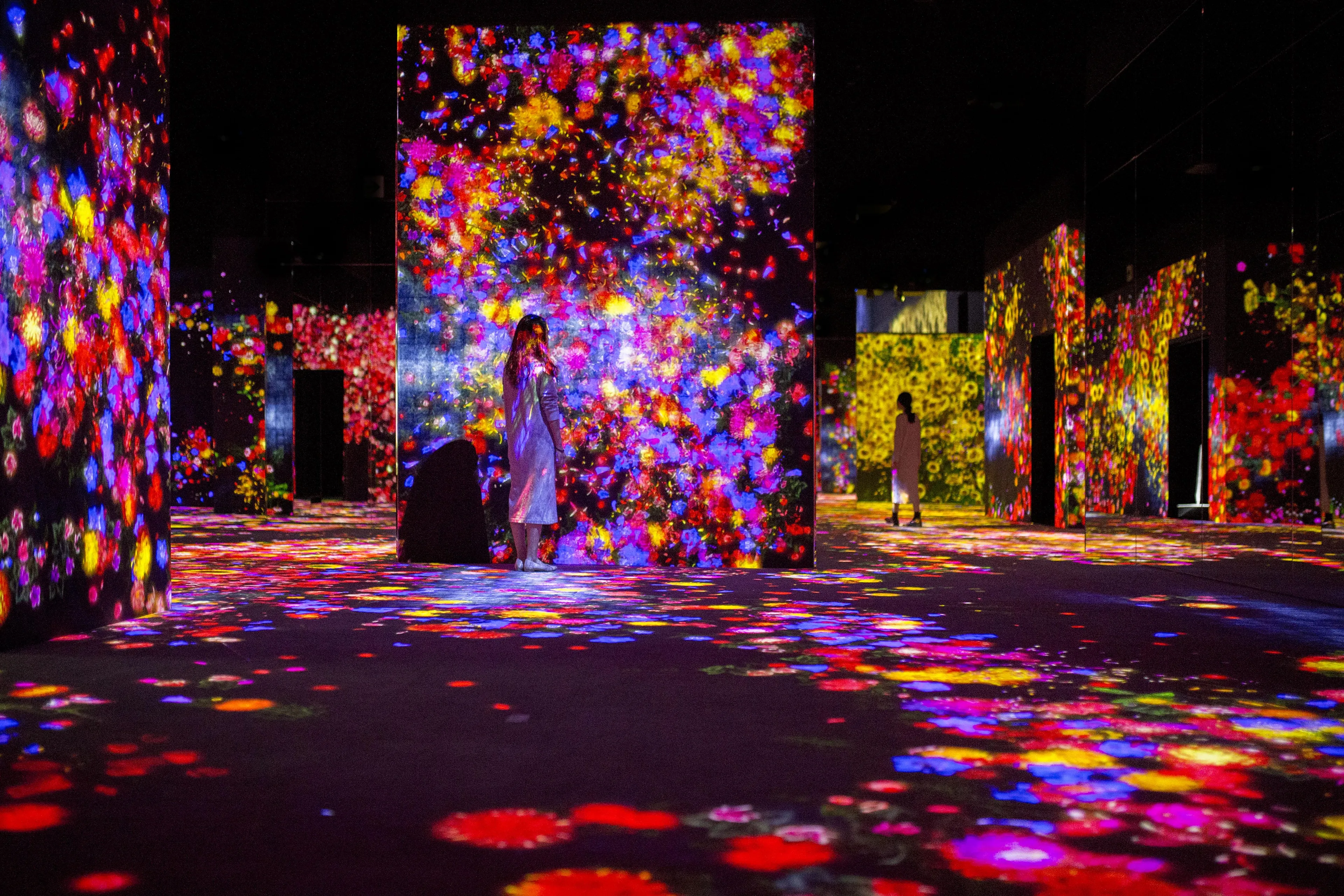
FEATURED WORKS

Black Waves: Lost, Immersed and Reborn
teamLab, 2019, Digital Installation, Continuous Loop, Sound: Hideaki Takahashi
The movement of water is simulated in a computer-generated three-dimensional space. The water is expressed as a continuous body after calculating the interactions of hundreds of thousands of particles. To visualize the waves, lines were drawn in relation to the movement of the particles. The waves created in 3-D space were then turned into an artwork in accordance with what teamLab refers to as ultrasubjective space.
In premodern Japanese painting, oceans, rivers, and other bodies of water were expressed as a series of lines. These lines give the impression of life, as though water is a living entity.
This form of expression leads us to question why pre-modern people sensed life in rivers and oceans. Also, why did they behave as if they themselves were a part of nature? Perhaps something can be discovered by fusing the fixed objective world of today’s common knowledge with the subjective world of premodern people.
While viewing this artwork, if we feel a sense of life in the collection of lines — what can be called the subjective world of premodern people — then perhaps this is one aspect of objective recognition.
When viewing this artwork, as opposed to when watching images of waves captured by a video camera, people may feel that the boundary between themselves and the waves disappears. They feel immersed in the work, perhaps even feeling life in the collection of lines, as if the waves are luring them in. Perhaps we can find a connection to the way premodern Japanese people perceived the world and, consequently, how they behaved toward the world.
If we regard ourselves as a part of nature and consider nature not just as something to be observed, we might join pre-modern people in perceiving rivers and oceans as living entities. This is a way of seeing the world that engages us, and allows us to feel that there is no boundary between ourselves and nature.

Flowers and People, Cannot be Controlled but Live Together – A Whole Year per Hour
teamLab, 2014-, Interactive Installation, Endless, Sound: Hideaki Takahashi
The seasons co-exist and change gradually across the installation space.
Flowers blossom according to the seasons, and the places where they grow gradually change.
The flowers bud, grow, and blossom before they begin to wither and their petals eventually scatter, repeating the cycle of life and death in perpetuity. If a person stays still, the flowers surrounding them grow and bloom more abundantly than usual, but if people touch or step on the flowers, they shed their petals, wither, and die all at once.
The artwork is not a pre-recorded image that is played back; it is created by a computer program that continuously renders the work in real time. The interaction between people and the installation causes continuous change in the artwork, so previous visual states can never be replicated, and will never reoccur. The picture at this moment can never be seen again.
In spring in the Kunisaki Peninsula, there are many cherry blossoms in the mountains and canola blossoms at their base. A visit to this region led teamLab to wonder how much of these flowers were planted by people and how much of them were native to the environment. It was a place of great serenity and contentment. The expansive body of flowers is an ecosystem influenced by human intervention, and the boundary between the work of nature and the work of humans is unclear. Rather than nature and humans being in conflict, a healthy ecosystem is one that includes people. In the past, people understood that they could not grasp nature in its entirety, and that it is not possible to control nature. People lived more closely aligned to the rule of nature, which perhaps created a comfortable natural environment. We believe that these valleys hold faint traces of this premodern relationship with nature that once existed, and we hope to explore a form of human intervention based on the premise that nature cannot be controlled.
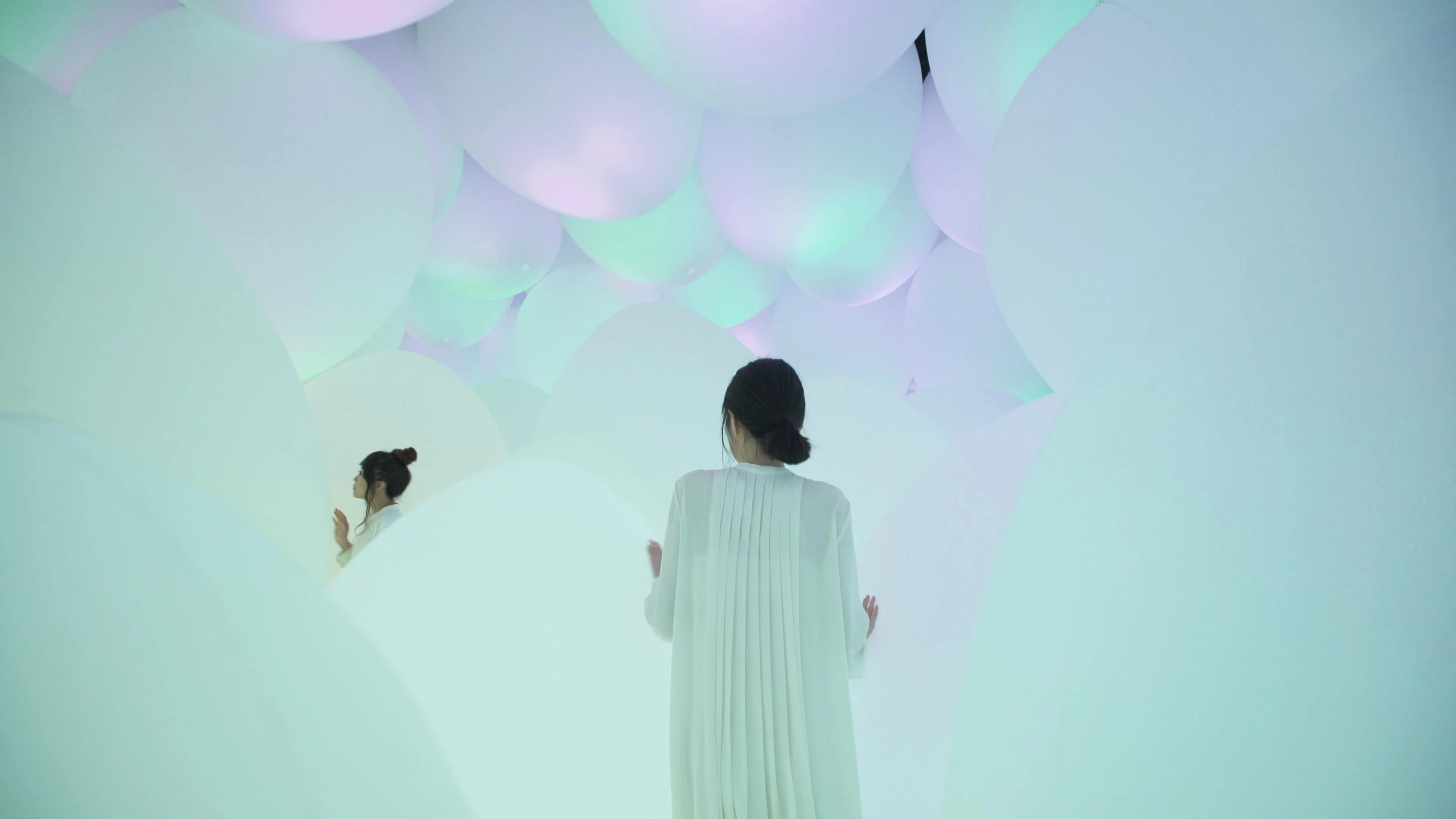
Weightless Forest of Resonating Life - Flattening 3 Colors and 9 Blurred Colors
teamLab, 2019, Interactive Digital Installation, Sound: Hideaki Takahashi
The space is filled with ovoids of light. People move through the ovoids and enter the space.
People recognize the multi-dimensionality of the space when the group of ovoids shine with various blurred colors, but the space feels flat when the ovoids are monochromatic. As the space changes between three dimensions and two dimensions, the whole body is immersed in both a three dimensional space and a flat plane.
When people strike the ovoids of light, it causes the color of the ovoid to change, and a tone specific to that color resonates out. The surrounding ovoids will respond, and the same color and tone will resonate radially throughout the space.
Each ovoid moves freely, but no matter where it is, the behavior of light is maintained across the entirety of the space. Therefore, the light behaves as a group and can be thought of as one three-dimensional existence. The light resonates out spherically across the space from the impacted ovoid. While recognizing the light’s three dimensional existence, people push through the ovoids to enter into that existence.
Since the ovoid colors are produced by light, it is possible to create 9 blurred colors (light in water, sunlight on water plants, morning glow, morning sky, sky at twilight, peach, plum, iris, and spring maple), as well as 3 colors that flatten the space (blue, red, and green), resulting in a total of twelve colors.
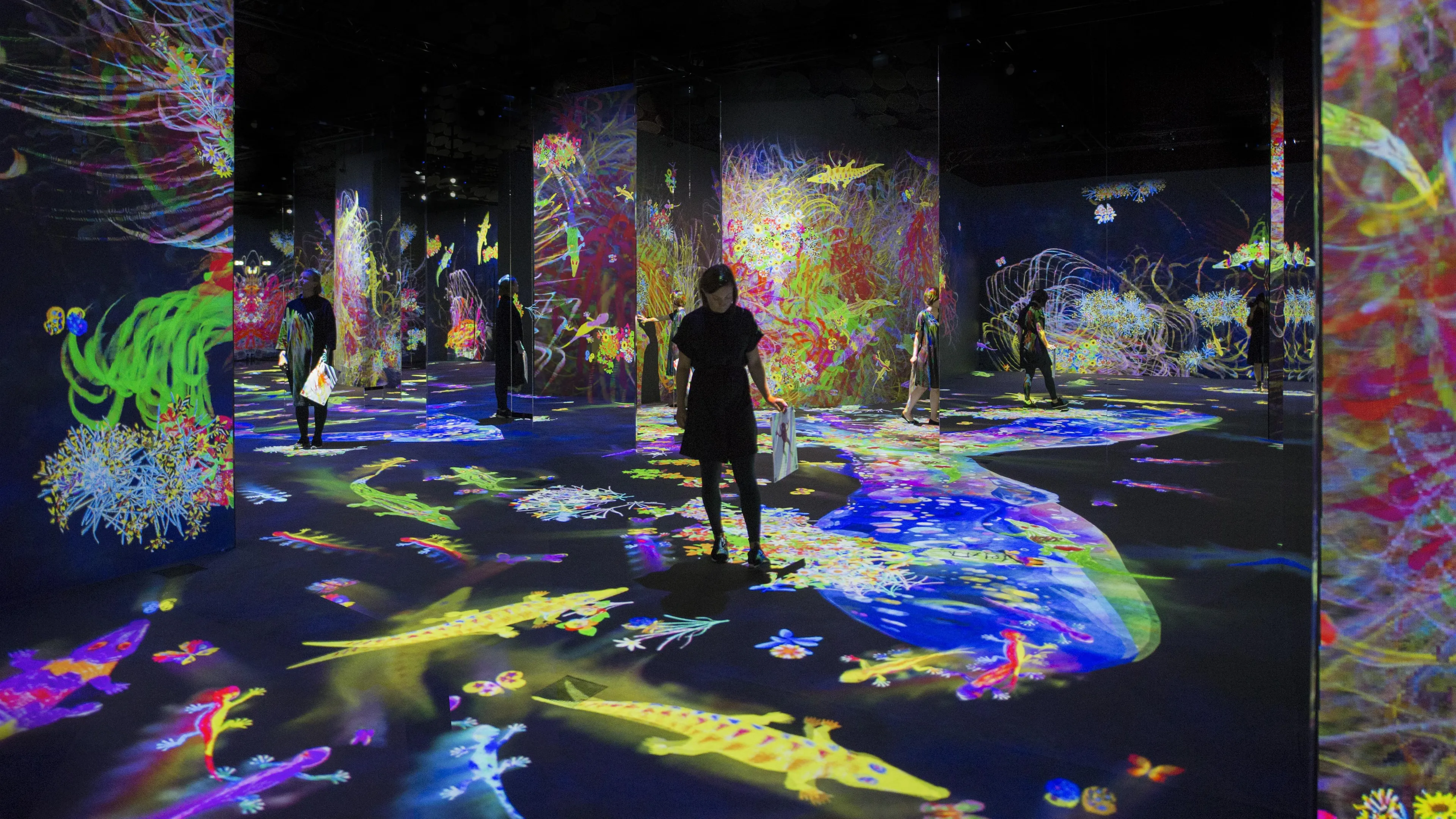
Graffiti Nature: Lost, Immersed and Reborn
teamLab, 2018, Interactive Digital Installation, Sound: Hideaki Takahashi
All the various creatures drawn by everyone live in this space. Color in a creature on the paper provided, and see the picture you have drawn come to life and move in front of you.
Living things eat and are eaten by other living things in one shared ecosystem.
The creatures you draw will multiply if they eat other living things, but they will die and disappear if they do not eat enough, or if they are eaten by other creatures.
The crocodiles eat the snakes, the snakes eat the lizards, the lizards eat the frogs, and the frogs eat the butterflies, each one propagating as they consume. Likewise, the butterflies multiply in places where flowers grow.
Although flowers will bloom if people stay still, their petals will scatter if people walk around and step on them. Crocodiles will die if people step on them too much.
As we immerse and meld ourselves into the work with others, we explore a continuity among people, as well as a new relationship that transcends the boundaries between people and the world.
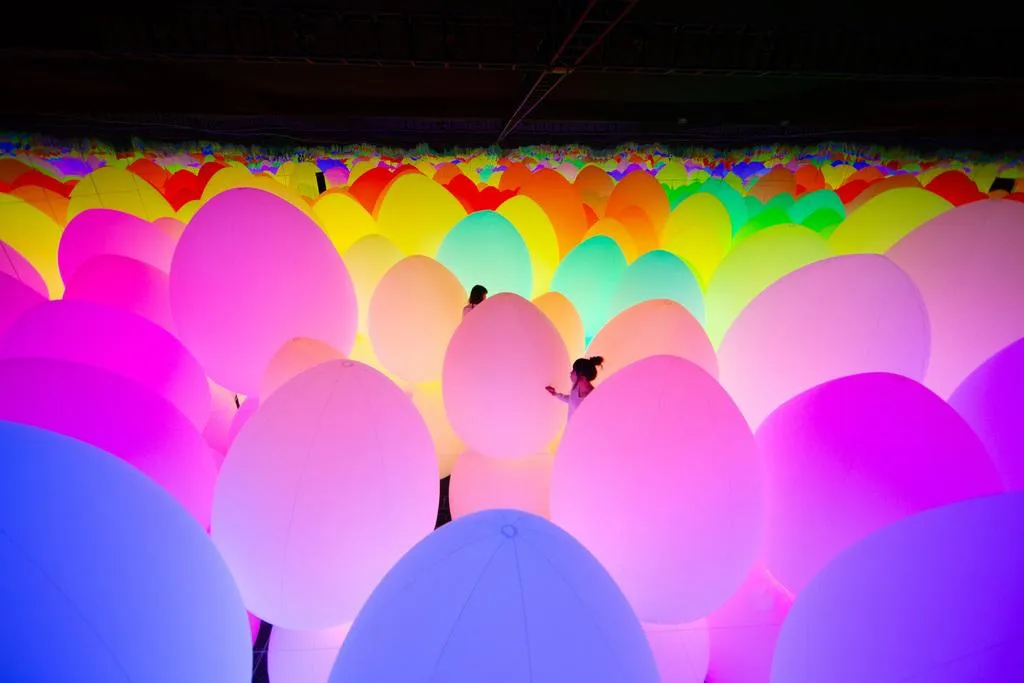
Resisting and Resonating Ovoids: Lost, Immersed and Continuous
teamLab, 2018, Interactive Installation, Endless, Sound: Hideaki Takahashi
The space is filled with resisting and resonating ovoids of light . People move through the ovoids and enter the space.
When an ovoid is pushed, the colour of the light it emits changes, and a tone unique to that color echoes out. The light that originated from that ovoid resonates out to other ovoids nearby. The tone resonates out continuously in the same way, as the light spreads throughout the ovoids in the space.
If a wave of light comes from the other side of the space, it signifies that there is another person in that location. As a result, people gain a heightened sense of awareness of the presence of other people in the same space.

